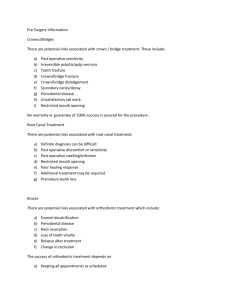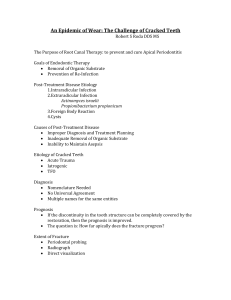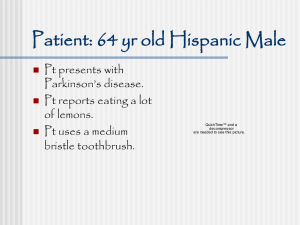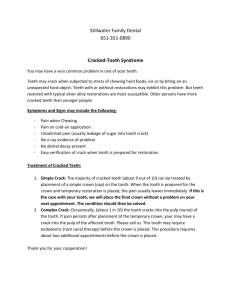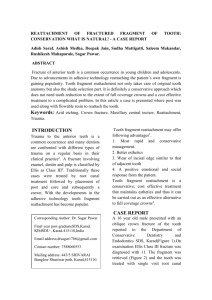hemisection: a treatment option for an endodontically treated molar
advertisement
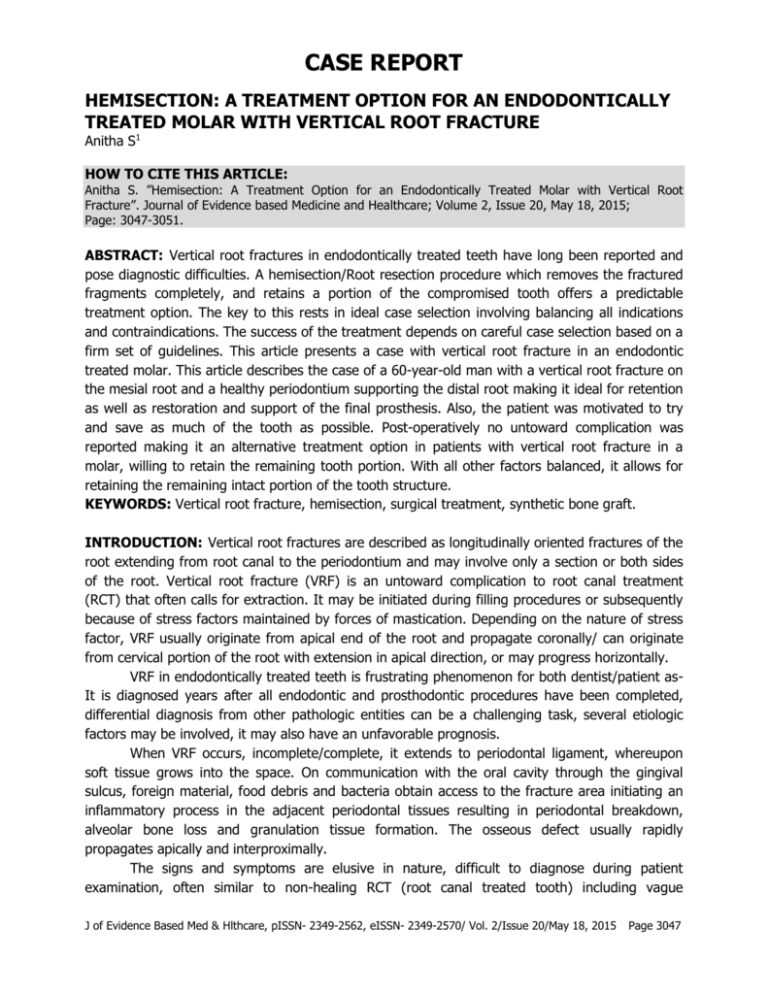
CASE REPORT HEMISECTION: A TREATMENT OPTION FOR AN ENDODONTICALLY TREATED MOLAR WITH VERTICAL ROOT FRACTURE Anitha S1 HOW TO CITE THIS ARTICLE: Anitha S. ”Hemisection: A Treatment Option for an Endodontically Treated Molar with Vertical Root Fracture”. Journal of Evidence based Medicine and Healthcare; Volume 2, Issue 20, May 18, 2015; Page: 3047-3051. ABSTRACT: Vertical root fractures in endodontically treated teeth have long been reported and pose diagnostic difficulties. A hemisection/Root resection procedure which removes the fractured fragments completely, and retains a portion of the compromised tooth offers a predictable treatment option. The key to this rests in ideal case selection involving balancing all indications and contraindications. The success of the treatment depends on careful case selection based on a firm set of guidelines. This article presents a case with vertical root fracture in an endodontic treated molar. This article describes the case of a 60-year-old man with a vertical root fracture on the mesial root and a healthy periodontium supporting the distal root making it ideal for retention as well as restoration and support of the final prosthesis. Also, the patient was motivated to try and save as much of the tooth as possible. Post-operatively no untoward complication was reported making it an alternative treatment option in patients with vertical root fracture in a molar, willing to retain the remaining tooth portion. With all other factors balanced, it allows for retaining the remaining intact portion of the tooth structure. KEYWORDS: Vertical root fracture, hemisection, surgical treatment, synthetic bone graft. INTRODUCTION: Vertical root fractures are described as longitudinally oriented fractures of the root extending from root canal to the periodontium and may involve only a section or both sides of the root. Vertical root fracture (VRF) is an untoward complication to root canal treatment (RCT) that often calls for extraction. It may be initiated during filling procedures or subsequently because of stress factors maintained by forces of mastication. Depending on the nature of stress factor, VRF usually originate from apical end of the root and propagate coronally/ can originate from cervical portion of the root with extension in apical direction, or may progress horizontally. VRF in endodontically treated teeth is frustrating phenomenon for both dentist/patient asIt is diagnosed years after all endodontic and prosthodontic procedures have been completed, differential diagnosis from other pathologic entities can be a challenging task, several etiologic factors may be involved, it may also have an unfavorable prognosis. When VRF occurs, incomplete/complete, it extends to periodontal ligament, whereupon soft tissue grows into the space. On communication with the oral cavity through the gingival sulcus, foreign material, food debris and bacteria obtain access to the fracture area initiating an inflammatory process in the adjacent periodontal tissues resulting in periodontal breakdown, alveolar bone loss and granulation tissue formation. The osseous defect usually rapidly propagates apically and interproximally. The signs and symptoms are elusive in nature, difficult to diagnose during patient examination, often similar to non-healing RCT (root canal treated tooth) including vague J of Evidence Based Med & Hlthcare, pISSN- 2349-2562, eISSN- 2349-2570/ Vol. 2/Issue 20/May 18, 2015 Page 3047 CASE REPORT headache and ear pain (extra-oral).(1) Intra-orally, signs and symptoms include mild pain, presence of sinus tract, exacerbation of a chronic lesion, pressure on mastication, a periodontal type of abscess,(2) pocket adjacent to fracture site, deep probing in one position around the circumference of the tooth in an otherwise normal attachment.(1) The radiographic features include hair-like fracture line radiolucency in the dentin/body accompanied with large losses surrounding the tooth/root (2), sometimes accompanied by a periapical/lateral periodontal radiolucency, with an angular bone loss (1), widening of periodontal space.(1) Diagnosis is by the history, examination for pain on mastication, prolonged discomfort, probing to detect osseous defect, IOPARs at two different angulations. An exploratory flap achieves a definitive diagnosis.(3) Predisposing factors include dental caries/trauma, narrow mesiodistal dimension compared to buccolingual dimension of the root, moisture loss in pulpal teeth, extensive use of rotary instruments to remove dentin, loss of alveolar bone, previous cracks in dentin, excessive lateral condensation of gutta-percha-main etiological factor, over preparation of canals for dowels(2) Clinical management includes use of CO2 /NdYAG, use of glass ionomer cement/laser/cyanoacrylate (1) to fuse fractured roots, which has been proved to be ineffective. In posterior teeth hemisection/root amputation may be considered as the treatment of choice, followed by a new restoration of tooth.(2,3) CASE REPORT: A male patient aged 60 years, with history of pain and swelling in a lower molar. History of mild pain on chewing in relation to the same, with history of root canal treated tooth in relation to the same 10 years back. The patient indicated there was pain but did not wish to have the tooth removed. On intra oral examination, there was swelling in 46 in the buccal aspect of the tooth. Exudation was noted from the sulcular area. The distal root was in good condition with no pocket/alveolar bone loss. There was no trauma from occlusion radiographically the fracture line was not very clear. Antibiotics and analgesics were prescribed and the patient was explained the prognosis. The surgical procedure was explained and scheduled. Patient’s consent was obtained. For hemisectioning, a surgical approach to visualize the furcation area is the most predictable technique. After anesthetizing, a full thickness periodontal flap was elevated to visualize the defect. A vertical fracture line was extending from the CEJ (cervico enamel junction) to the apical 3rd. An angular type of bone loss was present. Hemisectioning of the tooth was performed and the fractured root fragments along with the crown portions were removed. Hemisectioning of the tooth was performed and the fractured mesial root fragment was performed with a diamond bur. The tooth was carefully sectioned and the fractured mesial fragment was removed. Any defects on the sound distal root were smoothened. After the sectioning, bioactive glass (perioglas) bone graft material was placed and sutured. Post-operative instructions were given. The patient was prescribed antibiotics and analgesics. Patient was recalled after a week for suture removal. The next phase of the treatment schedule involved the restoration of the hemisected tooth with a provisional crown. Final prosthesis was given after 3 months. A full metal prosthesis with extension on 45 (3/4th crown) was designed. A trial was done. With the patient’s consent, J of Evidence Based Med & Hlthcare, pISSN- 2349-2562, eISSN- 2349-2570/ Vol. 2/Issue 20/May 18, 2015 Page 3048 CASE REPORT the prosthesis was cemented. Patient was re-called for re-evaluation after 1, 3, 6 months, 1 year and 2 years. The patient did not report any complaints/discomfort. The surgical area healed uneventfully. At each visit, the patient/s oral hygiene was evaluated. The patient reported once in 5 months after the first year. The patient’s oral hygiene was good and was able to maintain the area well and did not report any untoward complications after placement of the final prosthesis. DISCUSSION: VRF has long been a dilemma to the clinician as it can occur at various stages of treatment (instrumentation, obturation/post placement)/ post-treatment. As there are more number of people wanting to keep their teeth for longer, clinicians put in efforts to provide a wide range of treatment options based on the clinical situation, age, economic considerations of the patient, and the best available clinical evidence of successful treatment modality. The loss of posterior molar can result is several undesirable sequelae including shifting of teeth, collapse of the vertical dimension of occlusion, super eruption of opposing teeth, loss of supporting alveolar bone and a decrease in chewing ability. The treatment options to replace severely damaged and possibly un restorable teeth include removable partial denture, fixed partial denture and dental implants. Retaining what is present is quite vital. Hemi-section of the effected tooth allows the preservation of remaining tooth structure. The success of the treatment depends on careful case selection based on a firm set of guidelines making case selection a vital determinant in the longterm success of the procedure.(4) Hemisection of mandibular molars may be a viable treatment option when vertical root fracture has occurred and the other root healthy.(4,5) This case demonstrates an alternative treatment to extraction of a whole tooth and salvation of healthy tooth structure in a case where the patient did not wish to have the tooth removed. In this case the tooth had a healthy periodontium supporting the distal root, having a sound straight root structure that was ideal to act as support for the FPD. The angulation of the remaining root was ideal for the fabrication of the resulting final fixed restoration. There was no presence of TFO/bruxism added to the advantage. Finally, the patient was motivated to save as much of the tooth as possible. He was fully aware of the risks including the increased risk of caries in resected tooth. In this case, a two years follow-up revealed a good oral hygiene with no complaints from the patient suggesting that hemi sectioning is an alternative to extraction in cases of vertical root fracture in patients with ideal oral environment with capability and willingness to carry out proper oral hygiene measures. REFERENCES: 1. Alex. J. Moule and Bill Kahler: Diagnosis and managements of teeth with vertical root fractures: Review. Australian Dent Journ 1999, 44(2) 75-87. 2. Tamse Aviad. Vertical root fractures in endodontically treated teeth-signs and clinical management. Endodontic topics 2006, 13, 84-94. 3. Senem Yigit Otzer et al. Diagnosis and treatment of endodontically treated teeth with vertical root fracture-3 case reports with 2 years follow-up. J of endodontol 2011; 37 97102. 4. Kurtzman GM, Silverstein LH, Shatz PC Hemisection as a treatment alternative for vertically fractured molars. Compend contin Educ Dent 2006 Feb; 27(2): 126-9. J of Evidence Based Med & Hlthcare, pISSN- 2349-2562, eISSN- 2349-2570/ Vol. 2/Issue 20/May 18, 2015 Page 3049 CASE REPORT 5. Abrams L Hemisection-Technique and Restoration. Dental Clinics of North America, 1974 18(2- 4)15-44. Fig. 1: Pre-operative view-intraoral swelling in relation to 46 Fig. 2: Surgical view- full thickness flap raised, vertical fracture line in the mesial root of 46 extending from CEJ to the apex, bone loss seen around the same Fig. 3: Surgical – after removal of fractured segments with periapical granuloma at the apex of the mesial root J of Evidence Based Med & Hlthcare, pISSN- 2349-2562, eISSN- 2349-2570/ Vol. 2/Issue 20/May 18, 2015 Page 3050 CASE REPORT Fig. 4: Post-surgical. One-year follow-up. Fixed partial prosthesis in relation to 45, 46 Fig. 5a & b: Comparison of pre-surgical and post-surgical (2 year follow-up) AUTHORS: 1. Anitha S. PARTICULARS OF CONTRIBUTORS: 1. Reader, Department of Periodontics, JSSDCH, JSSU. NAME ADDRESS EMAIL ID OF THE CORRESPONDING AUTHOR: Dr. Anitha S, Department of Periodonticts, JSSDCH, JSSU. E-mail: anithasu79@gmail.com Date Date Date Date of of of of Submission: 03/05/2015. Peer Review: 04/05/2015. Acceptance: 09/05/2015. Publishing: 18/05/2015. J of Evidence Based Med & Hlthcare, pISSN- 2349-2562, eISSN- 2349-2570/ Vol. 2/Issue 20/May 18, 2015 Page 3051
